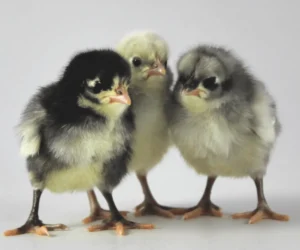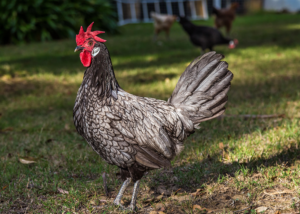Meet the Andalusian Chicken
Welcome to our guide on Andalusian chickens! These vibrant birds have a rich history and fascinating traits that make them a joy to raise. Let’s dive into the world of Andalusian chickens and discover everything you need to know about caring for them. Andalusian chickens hail from the Andalusia region of Spain, where they have been cherished for centuries. Originally bred for their striking appearance and egg-laying abilities, Andalusian chickens quickly gained popularity across Europe and eventually found their way to other parts of the world.
Egg-cellent Eggs: Size, Color, and Production
Size
Andalusian chicken eggs come in various sizes, usually medium to large.
Color
The Andalusian hens lay white colored eggs.
Production per year
Andalusian hens are capable of producing around 160 to 180 eggs per year.
When do Andalusian chickens start laying eggs?
They typically start laying eggs when they’re about 5 to 6 months old, so you won’t have to wait too long to enjoy their delicious eggs.
Andalusian Chicken Breed Characteristics
Temperament and Pet Potential: Friendly Feathers
Andalusian chickens are known for their friendly and active temperament, making them great pets for families and hobbyists alike. With proper handling and care, they can become quite tame and enjoy interacting with their human companions.
Taming Andalusian Chickens: Building Trust
Taming Andalusian chickens is a gradual process that requires patience and consistency. Spend time with them every day, offering treats and speaking to them in soothing tones. With time and patience, they’ll learn to trust you and may even enjoy being handled.
Ideal Andalusian chicken flock size
For Andalusian chickens, a flock size of 4 to 6 birds is ideal. This ensures they have enough social interaction without feeling overcrowded. Plus, they’ll be happier and healthier when they have plenty of feathered friends to keep them company.
Space Requirements: Room to Roam
Andalusian chickens are active birds that appreciate plenty of space to roam and forage. Provide at least 4 square feet of coop space per bird, along with outdoor access if possible. This will ensure they stay happy and healthy.
Getting Along with Others: Feathered Friends
Andalusian chickens generally get along well with other chicken breeds, especially when they’re raised together from a young age. Introduce new chickens slowly and monitor their interactions to ensure everyone gets along.
Appearance: Beauty in Blue
Andalusian chickens are known for their stunning appearance, with shimmering blue feathers that catch the eye. They have sleek, athletic bodies and bright red combs and wattles that add a pop of color to their appearance.
Nutritional Needs: Feeding Your Andalusian Flock
Feeding Andalusian Chicks: Birth to 8 Weeks
- Starter Feed: From the moment Andalusian chicks hatch until they reach around 8 weeks of age, it’s crucial to provide them with a high-quality starter feed specifically formulated for young chicks. This starter feed is specially designed to meet the nutritional needs of growing chicks, containing essential vitamins, minerals, and proteins necessary for healthy development.
- Protein Content: Look for a starter feed with a protein content of around 20% to support the rapid growth and development of Andalusian chicks during their early stages. Protein is essential for building strong muscles, feathers, and internal organs.
- Feeding Frequency: Offer starter feed to Andalusian chicks ad libitum, meaning it should be available to them at all times. Chicks have small stomachs and high metabolic rates, so frequent access to feed is essential for optimal growth.
- Supplemental Heat: Provide a warm and draft-free environment for Andalusian chicks, as maintaining the right temperature is crucial for their health and well-being. Use a heat lamp or brooder to provide supplemental heat, keeping the temperature around 90-95°F (32-35°C) during the first week and gradually reducing it by 5°F (2-3°C) per week until they are fully feathered.
- Fresh Water: Alongside starter feed, provide fresh, clean water to Andalusian chicks at all times. Use shallow waterers to prevent accidental drowning, and ensure the water is changed regularly to maintain cleanliness and hygiene.
Transitioning to Grower Feed: 8 Weeks to Point of Lay
- Grower Feed Introduction: Around 8 weeks of age, begin transitioning Andalusian chicks from starter feed to grower feed. Grower feed contains slightly lower levels of protein compared to starter feed but still provides the essential nutrients needed for continued growth and development.
- Protein Content: Choose a grower feed with a protein content of around 16% to 18% to support the ongoing growth and development of Andalusian chickens as they transition from chicks to pullets.
- Feeding Schedule: Offer grower feed to Andalusian chickens in measured quantities, ensuring they have enough feed to satisfy their hunger without overfeeding. Monitor their appetite and adjust the feeding amounts as needed to prevent wastage and promote healthy growth.
- Healthy Treats: Introduce small amounts of healthy treats such as finely chopped greens, fruits, or mealworms to Andalusian chickens as occasional supplements to their diet. These treats provide enrichment and variety while offering additional nutrients.
Preparing for Egg Production: Point of Lay Onward
- Layer Feed Transition: As Andalusian chickens approach the point of lay, typically around 18 to 20 weeks of age, transition them to a specialized layer feed formulated specifically for laying hens. Layer feed contains higher levels of calcium and other nutrients necessary for egg production and shell formation.
- Calcium Supplementation: Alongside layer feed, provide free-choice calcium supplements such as crushed oyster shells or limestone grit. Calcium supplementation is crucial for Andalusian hens to produce strong, healthy eggshells.
- Feeding Routine: Continue offering layer feed and supplemental calcium to Andalusian hens on a regular schedule, ensuring they have access to fresh water at all times. Monitor their egg production and adjust feed quantities as needed to support optimal laying performance.
By providing a balanced and nutritious diet tailored to each stage of development, you can support the healthy growth, development, and eventual egg-laying success of your Andalusian chickens. Consistent access to high-quality feed, fresh water, and appropriate supplements is key to ensuring their well-being and productivity throughout their lives.
Strengths and Weaknesses: Evaluating the Andalusian Chicken
Andalusian chickens are prized for their egg-laying abilities, friendly demeanor, and striking appearance. However, they can be prone to health issues like Marek’s disease, so it’s essential to keep an eye on their well-being and provide proper care.
Embrace the Beauty of Andalusian Chickens
In conclusion, Andalusian chickens are delightful birds with a lot to offer. Whether you’re drawn to their stunning appearance or their egg-laying prowess, these colorful chickens are sure to bring joy to your flock. With proper care and attention, you can enjoy the company of Andalusian chickens for years to come.


